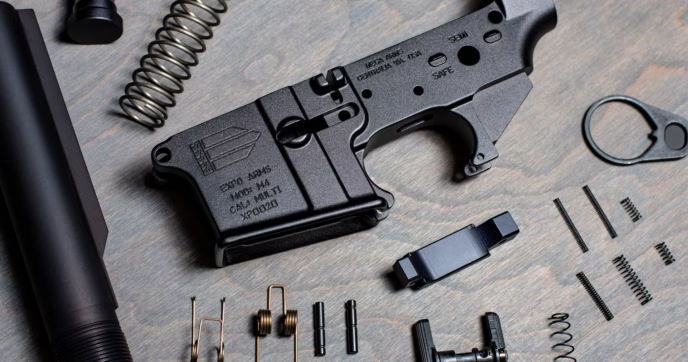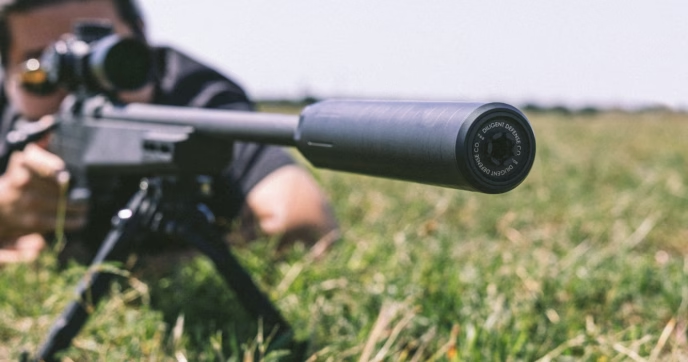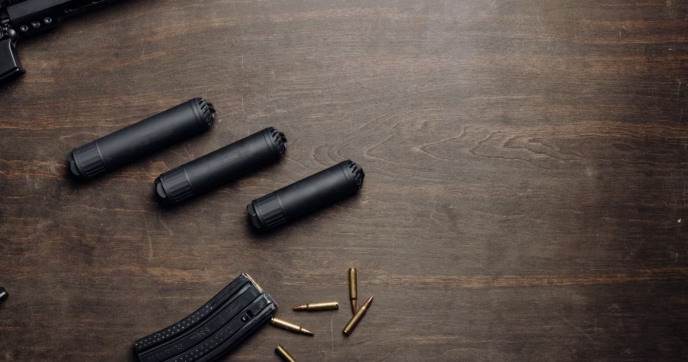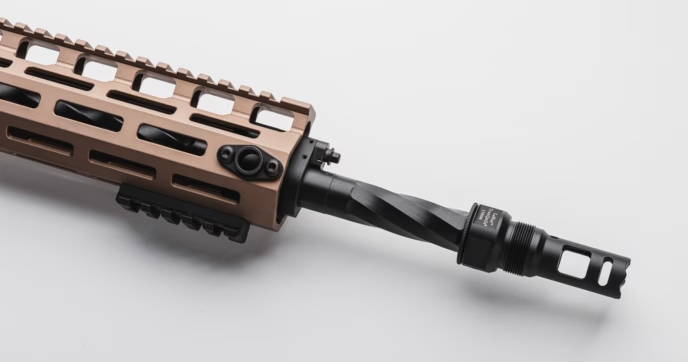Firearms and noise are synonymous. While they’re certainly powerful tools, regardless of whether you’re shooting a small caliber pistol or a larger full-power rifle, they have extremely loud sound signatures, reaching upwards of 150+ decibels sometimes—more than enough to cause permanent hearing damage. Hearing protection is always necessary for shooting, but accessories like suppressors can improve your hearing safety immensely.
If you aren’t already familiar with them, a suppressor is a specialized muzzle device that’s designed to reduce the sound signature and muzzle flash of a firearm. Unlike other muzzle devices that divert gases outward, suppressors have a series of baffle chambers that capture them, muffling the sound they create after ignition. Since they’re so effective, it’s become more common to see enthusiasts running suppressors on their rifle and pistol setups, especially since the introduction of quick-detach (QD) suppressors.

Quick-Detach Suppressors: What are They?
Quick-detach (QD) suppressors are a quicker alternative to more traditional direct-thread options, relying on a QD locking mechanism instead of your barrel’s threads to mount. While direct-thread suppressor models are still effective, they take longer to remove and require multiple thread-adapters to make them work on different rifles and pistols with varying thread pitches, further adding to the time it takes to remove and install them.
Despite there being several unique QD suppressors available, they all work similarly in that they’re designed to mount to a specially designed muzzle device rather than the barrel itself, with different models being compatible with different mount designs. For example, Dead Air suppressors typically mount to muzzle devices using their KeyMount system, meaning options like the HUXWRX FLOW or SureFire SOCOM models can’t mount to it.
Additionally, the QD mounting profile stays consistent regardless of the muzzle device size—meaning the mounting pattern for a 1/2×28 muzzle device is the same for a larger 5/8×24 variant of the same design. This is why QD suppressors have become a go-to option for those wanting to use one suppressor on multiple setups. Multi-caliber suppressors like the SilencerCo Hybrid 46M can suppress caliber diameters as large as .458 SOCOM, meaning it can suppress smaller calibers such as .308 and 5.56 NATO too. With this in mind, you can use a SilencerCo ASR compatible muzzle device on your rifles, allowing you to easily move it over to each platform with no issue.
Quick-Detach vs. Direct-Thread Suppressor: Making the Right Choice
Although QD suppressors certainly have their advantages, like any accessory, they come with their drawbacks. Both QD and more traditional direct-thread suppressors offer their own unique benefits, so it’s paramount that you understand them before choosing one over the other.

Quick-Detach Pros and Cons
Pros: QD suppressors offer the most in terms of convenience. By design, they make the installation and removal process very quick, which is ideal for cleaning or mounting it to another firearm. Their locking mechanisms are incredibly secure too, offering solid retention so they won’t loosen while in use.
Since they mount to a muzzle device instead of directly to the barrel, your barrel’s threads are always safe from any excess wear and damage, since the muzzle device remains secured to the barrel, whether your suppressor is mounted or not. Lastly, since they use a standardized mounting system, there’s no need to use extra adapters when moving it over to a different rifle or pistol, since the mounting profile stays the same across all muzzle devices, regardless of size. So long as the mounting profile matches, you’re good to go.
Cons: One of the greatest cons of QD suppressors is tolerance stacking. Tolerance stacking refers to the tolerance variation in each threaded component. Depending on how they were machined, the tolerance of each part can have some variance, which can potentially affect your suppressor’s alignment. Misalignment can result in several performance issues or even a baffle strike (when the bullet hits the baffles of the suppressor) in a worst-case scenario. Baffle strikes cause severe damage to your suppressor, potentially rendering it unusable, making proper alignment paramount. While daunting, if you use high-quality components, install everything properly, and check your alignment with an alignment rod, you won’t have any issues when using a suppressor.
Additionally, QD suppressors generally cost more than direct-thread models since they require the use of more complex locking mechanisms and muzzle devices. Keep in mind that this isn’t the case for every model since prices vary, but for more premium offerings like those from KAC and SureFire for instance, there’s often a noticeable difference in price. Also, while not too great of a concern, the addition of a QD locking mechanism can add weight to your suppressor. Granted, it’s typically no more than a few ounces, but it’s worth considering if you’re trying to keep your build as light as possible.

Direct-Thread Pros and Cons
Pros: Direct-thread suppressors are as simple as they come. Mounting directly to the barrel’s threads, there’s no need for QD muzzle devices. So long as the suppressor insert is compatible with your barrel’s thread pitch, you’re good to go. The lack of added components keeps their production cost low, resulting in them costing less compared to QD models. Still, it’s important to bear in mind that the price of each suppressor varies depending on the brand as well as the materials they’re made of, so this isn’t always the case.
Since they have fewer components, they’re also less prone to succumbing to tolerance stacking, since the mounting process only comes down to the barrel threads and the suppressor itself. As such, there’ll be a smaller chance of having a baffle strike or other misalignment issues.
Cons: Direct-thread suppressors aren’t without their drawbacks. Mainly, they’re only compatible with one thread pitch, unless you decide to use a thread adapter, or a specialized direct-thread suppressor insert. This can make running one suppressor on multiple rifles tricky, as you’ll need to switch over to different inserts to make it work properly on whichever rifles or pistols you want to suppress.
Something else to consider is that direct-thread options aren’t locked into place like QD ones are. While firing, the barrel harmonics can loosen your suppressor over time. While you can use a thread locker to keep it secure, this can make its removal difficult. Lastly, since they mount directly to the barrel, you’ll need to take extra care to not cross-thread your suppressor when mounting it. If your threads deform or break, you’ll lose the ability to mount anything to your rifle, and you may damage your suppressor in the process. Also, after removal, your barrel threads will be exposed, so we highly recommend covering them with a thread protector.
Which is best?
At the end of the day, it’s important to recognize that neither QD nor direct-thread suppressors are inherently better than the other, as each one offers its own pros and cons. QD suppressors are the move if you’re interested in using one suppressor on multiple firearms, or just want the ability to quickly remove your suppressor while still having a muzzle device fixed to your gun. In contrast, direct-thread is better if you’re wanting to keep one firearm suppressed. Either way, at the end of the day, the best option is the one that meets your needs and preferences best.
Suppressor Brands

SureFire: Well-known for their range of industry-leading weapon light options, SureFire also offers some of the most sought-after suppressors on the market. Their lineup consists of several distinct models, with the SOCOM series being among their most notable.
The SureFire SOCOM is an iconic suppressor that’s lightweight and rated to withstand harsh use. These rifle suppressors come with a reinforced locking collar for optimal retention, and they’re compatible with SureFire’s Fast Attach muzzle devices. Additionally, they’re available in either a black or flat dark earth finish, and they’re offered in either a 7.62 or 5.56 configuration.

HUXWRX: HUXWRX is a prominent name in the suppressor industry, well known for producing an assortment of flow-through suppressors. Flow-through suppressors allow the gases to pass through and vent out the front of the suppressor rather than blowing back into the receiver. Gas blowback can be an issue when shooting suppressed, making a flow-through can a solid choice for some added comfort.
With multiple models to choose from, the HUXWRX FLOW series is arguably their most notable. Coming in several variations, such as the FLOW 7.62 and FLOW 5.56, they’re made from 17-4 PH Stainless Steel, are full auto rated, and have passed 6 SOCOM stress test cycles, making them a more than capable option to choose. They’re offered in a QD configuration as well and are compatible with any of HUXWRX’s Torque Lock muzzle devices.

JK Armament: A relatively new name in the industry, JK Armament was founded in 2019, and has since garnered a substantial reputation for the level of quality found in their suppressor offerings. They offer a diverse range of modular suppressors such as their JK 155 series. Coming with adjustable baffles, you can configure them to find the level of suppression that’s optimal for your setup.
In its shortest configuration, the JK 155 SBRX is 3.3 inches long and weighs only 4.4 ounces—in its full-length configuration it’s 6.6 inches long with 5 baffles and weighs 12.8 ounces. These suppressors can be an excellent choice for multiple applications. Plus, they’re QD compatible and come with their PRO Quick Attach Taper Mount.

Yankee Hill Machine: Yankee Hill Machine is another excellent suppressor manufacturer, known for producing high-quality options fit for all budgets. There are a lot of solid suppressor choices in YHM’s lineup, with them offering options for 5.56 NATO and 7.62 NATO rifles, as well as 9mm pistol suppressors. One of their more notable models is their TURBO T3.
Rated for full-auto use, TURBO series suppressors blend utility with affordability. They’re made from stainless steel, making them a durable option that’s suitable for all applications, plus, they’re compatible with YHM’s Phantom QD Mount as well. These suppressors come standard with a Phantom QD Flash Hider too.
Process of Purchasing a Suppressor
We go in-depth on the purchasing process in our guide, “How Can I Buy a Suppressor?” but buying a suppressor is more involved than buying other firearm accessories. Notably, they’re regulated under the National Firearms Act (NFA), making them an NFA item much like short-barreled rifles (SBRs). As such, the purchasing process looks a bit different compared to buying a rifle or handgun.
When you purchase your suppressor, you’re required to fill out a Form 4. This form is the application for the tax paid transfer and registration of your suppressor, and it’s a lot like the 4473-paperwork required to purchase a firearm. Alongside your suppressor, you’ll also have to buy a $200 tax stamp, which is required to own any NFA item. It covers the federal tax that needs to be paid when submitting a Form 4—depending on how you file your Form 4, you can either pay for it at the same time as your suppressor, or you can send in a check with your paperwork. You’ll also need to submit a set of fingerprints on an FD-258 fingerprint card.
After you’ve sent off your paperwork and paid for everything, you can’t take your suppressor home just yet. Like other NFA items, the paperwork needs to be processed and approved before you’re able to take it home. This process can take anywhere from days to weeks or even months in some cases. While waiting for approval is inevitable, you can speed up the process by filing for one digitally. Approval on digital Form 4s tends to come back in a matter of weeks, while traditional paperwork often takes considerably longer.
Conclusion
Suppressors are often considered one of the greatest accessories an enthusiast can buy. By reducing the sound signature and muzzle flash of your rifle, they provide numerous benefits that can enhance your rifle’s overall performance. Notably, QD suppressors have gained an incredible amount of traction and popularity amongst enthusiasts.
Despite having some disadvantages, QD suppressors have the ability to be quickly removed and remounted onto your rifle, making their installation incredibly fast and effective. Plus, with the rising popularity of multi-caliber suppressors, you can easily move your suppressor from one platform to the next, so long as you have the right QD muzzle device.
At the end of the day, QD suppressors are here to stay. Although there are several top-tier options to pick from, if you’ve taken your needs into account and the model you’re looking at checks off all your boxes, you can rest assured knowing you’ve made the right choice. If you’re looking into purchasing a pistol suppressor for your handgun, our guide on recoil management techniques highlights various techniques that can aid you in shooting with a suppressor.




